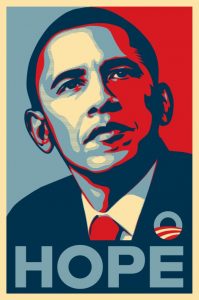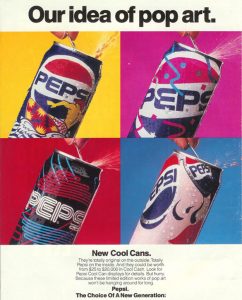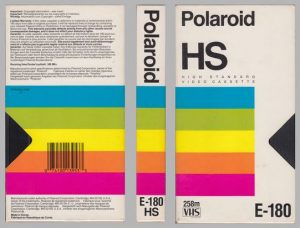Set designer, Es Devlin stated art should ‘show’, ‘reveal’ and ‘deconstruct’ (Devlin, 2017). These three elements are present within Postmodernist design. Postmodernism began in the 1970s/80s, rejecting modernism by contradicting the functional style.
Image one is the Obama Hope poster designed by Shepard Fairey in 2008 as a grassroots project to get Obama elected. This is one of my favourite works due to the limited and patriotic colour palette and the message promoted. It’s deconstructed due to the different colours separating the face and creating shadow. This separation reveals, and shows, as you are drawn to all the different parts as the contrasting colours highlights different areas.
Image two is a Pepsi Cool Cans advert from 1990. Part of Postmodernism is the bright colours seen in the branding and packaging design with the block colour backgrounds and cans themselves. Pepsi’s brand colours, red, blue and white, are evident on the cans but the pop art style is what distinguishes them from the standard cans. There was controversy around the cans as when stacked, sex was spelt out down the side. This revealed a message, said to emphasise the idea of being sexier in the summer. The usual graphics would’ve been deconstructed and reinterpreted in a pop art style for these cans.

Image three is a VHS tape cover. VHS tapes were used to watch movies in the Postmodernist era. This Polaroid VHS uses five stripes of vibrant colour, reflecting the movement. The cover deconstructs as it separates information, especially on the back. Polaroid is an established brand in photography and the use of colour shows how the brand uses colour and reveals that the tape is in colour.

Marshall McLuhan played a large part in Postmodernism and said ‘art is what you can get away with’ (McLuhan, 1951). This is true as anything can be seen as Postmodernist and it’s about pushing the boundaries. Unknown Twitter author ‘overlyxclusive’ wrote ‘Art is freedom. Being able to bend things most people see as a straight line’ (Overlyxclusive, 2013). This works for Postmodernism as it is seeing things differently and exploring things in a new way to push art further.
References
- Abstract: The Art of Design – Season 1, Episode 3 – Es Devlin: Stage Design (2017) TV series. USA: Netflix.
- Obama-hope-shelter-copy (2008) JPEG digital image. obeygiant.com. [Online] Available from: https://obeygiant.com/obama-hope/ [Accessed 14 November 2017]
- jpg (uploaded 2011) JPEG digital image. blog.signalnoise.com. [Online] Available from: http://blog.signalnoise.com/2011/11/02/pepsi-cool-cans/ [Accessed 14 November 2017]
- Polaroid-High-Standard-E180 (N/A) JPEG digital image. cdn1.goughlui.com. [Online] Available from: http://cdn1.goughlui.com/wp-content/uploads/2014/02/Polaroid-High-Standard-E180.jpg [Accessed 14 November 2017]
- OVERLYXCLUSIVE (2013) Overlyxclusive [Online] Twitter. Available from: https://twitter.com/overlyxclusive/status/377835684348067840 [Accessed 14 November 2017]
- MCLUHAN, M. (1951) Andy Warhol & Marshall McLuhan: The Artist & the Visionary [Online] mcluhangalaxy.wordpress.com. Available from: https://mcluhangalaxy.wordpress.com/2011/12/08/andy-wharhol-marshall-mcluhan-the-artist-the-visionary/ [Accessed 14 November 2017]
